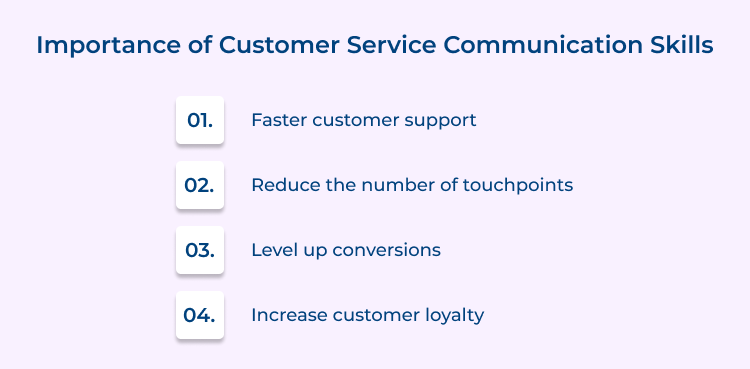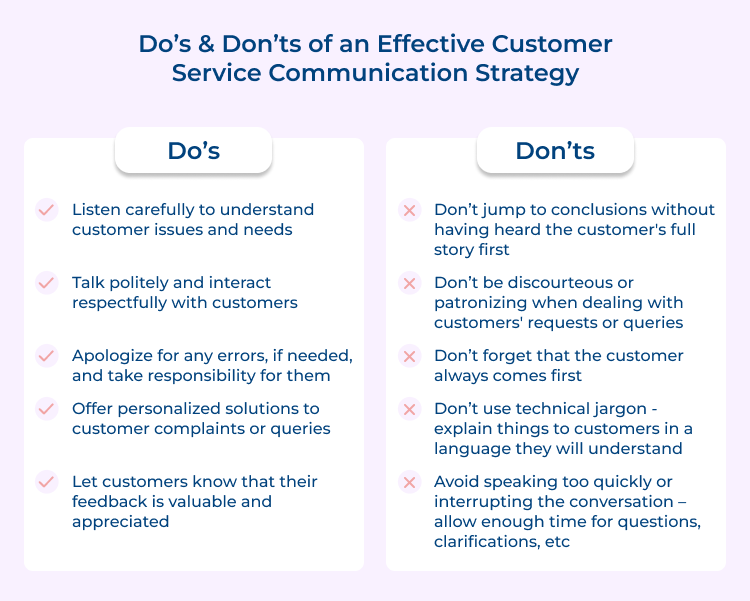Customer service communication is immense on the success of any business — as the cost of poor customer communication has hit an overwhelming $37 billion according to a Holmes report.
Effective customer support communication helps develop trust between customers and the company. It can be easy to drop the ball by overlooking something or not addressing a customer’s needs in an efficient manner.
Fostering good customer communication skills should be an integral part of the company’s values. Improving communication helps promote your brand to future customers, build a strong relationship with existing customers, and address customer concerns.
To help ensure that your customer interactions are always at a high level, we have summarized customer service communication best practices and tips.
Investing time and energy in these tips can transform your customer interactions from being average or even below average into entertaining conversations that truly engage customers.
What is Customer Service Communication?
Customer service communication is all about interacting with your customers in a professional manner using the right customer service channels that align with their expectations. It involves responding to inquiries, solving problems, managing complaints, addressing customer complaints or feedback, and so on.
Good customer service communication gives customers quick responses that help create positive experiences. Customers need assurance that their issues will be handled quickly so they can continue to enjoy the products or services you offer them. Additionally, good customer communication helps in building customer trust, which leads to higher brand loyalty.
Importance of Customer Service Communication Skills
Good customer service communication skills are the most important traits for improving the bottom line of every business. Whether it is internal or external communication management, you should be able to communicate flawlessly to make it effective.

If you communicate well with customers, your odds of success in business greatly increase in the following ways:
- Faster customer support: Effective communication with customers helps to learn the client’s problem accurately and enables you to deliver faster support.
- Reduce the number of touchpoints: Acquiring better knowledge of the customer problems helps in delivering faster solutions in the first go itself, which reduces the number of touchpoints.
- Level-up conversions: Assisting customers with the right answers in real time helps to close sales faster and increase sales conversions.
- Increase customer loyalty: Having personalized conversations with customers with the help of digital engagement tools builds trust and cultivates loyalty with your customers.
15 Proven Ways for Effective Customer Service Communication
It’s no surprise that excellent customer service communication is the foundation of reliable, long-term relationships between businesses and their customers. But there are always ways to further improve customer service communications and make them even more effective.
Here are 15 powerful methods to help you develop an effective customer service communication strategy.
- Provide Seamless Omnichannel Experience
- Use Knowledge Base for 24×7 Support
- Personalize Content To Fit Your Customers’ Needs
- Maintain Transparency When Dealing With Problems
- Quickly Respond To Queries And Complaints Alike
- Offer Real Time Assistance with Live Chat
- Leverage AI Chatbots to Reduce Response Times
- Monitor Online Reviews Systematically
- Gather Customer Service Analytics
- Personalize Communications Whenever Possible
- Engage With Customers Through Social Media
- Train Your Customer Service Team Regularly
- Implement Quality Assurance Programs
- Collect Customer Feedback to Improve Communication Skills
- Avoiding Jargon and Technical Terms if Possible
Let’s dive in!
1. Provide Seamless Omnichannel Experience
Businesses that adopt an omnichannel customer service strategy retain an average of 89% of customers compared with 33% for those with weak omnichannel strategies.
It is very important to connect with customers where they are and deliver consistent support across all channels. Consumers expect a seamless cross-channel experience from their favorite brands. An omnichannel approach merges different communication channels into one unified platform; making interaction with customers effortless and natural.
Your customers should receive relevant information from each channel they use so that they can get answers anytime and anywhere without having to repeat themselves or start all over again. It will ensure that any inquiries or communications sent through emails, social media, chat apps, etc., can all be accessed in one place.
Focus on three core parameters to enhance customer experience:
- Identify the communication channels preferred by your customers.
- Create an effective customer engagement strategy across the identified channels.
- Deliver a consistent experience throughout the customer journey.
Sephora builds an omni-channel experience that connects its shoppers’ online purchases to their in-store visits. It allowed customers to use in-store tablets to access their Beauty Bag account while shopping. Customers can look up item details and virtually try on products using digital software.
2. Use Knowledge Base for 24×7 Support
A knowledge base is an online library full of helpful articles that allow customers to help themselves without having to reach out directly for assistance.
Such a library or repository could include FAQs and instructional articles on topics like setup guides or product features as well as troubleshooting advice for common technical problems.
A knowledge base not only provides valuable resources for users who don’t want to contact support every time but also helps free up resources from your team by allowing them to focus solely on complex issues and more complicated tasks.
Knowing what your customers want and keeping things ready will help them positively. It also helps to reduce repetitive interactions by the customer and improves customer communication skills.
3. Personalize Content to Fit Your Customers’ Needs
Personalization is key when it comes to keeping customers happy and engaged with your brand. Customers expect personalization when they’re shopping online, and are annoyed when brands fail to deliver it.
Personalized messages show customers you understand their needs and make them feel valued by giving them a tailored response rather than blanketed messages sent out across all channels.
There are plenty of tools available that can help you craft unique messages based on prior customer data or even automation software that can automate responses based on certain conditions such as frequently purchased items or search terms previously used.
4. Maintain Transparency When Dealing with Problems
Good customer service isn’t just about solving problems; it’s also about being honest with your customers.
When you are transparent about the solutions that you are offering to resolve their problems, it creates trust and loyalty between the two parties.
If there are issues within the operation that might cause delays or prevent orders from being fulfilled properly then you should be upfront with your customers about the situation in order to keep them informed before things escalate any further.
5. Quickly Respond to Queries and Complaints Alike
It hasn’t been lost on today’s consumers that speed matters when it comes to resolving their queries or complaints.
90% of consumers said that getting an immediate response to their customer service questions is important or very important.
A slow response time can leave them feeling frustrated and ignored, eventually bringing down their opinion (and by extension loyalty) toward your brand.
Establishing a clear process for responding quickly ensures that everyone feels heard which will not only boost overall satisfaction but could also drive more sales down the road due to positive word-of-mouth marketing by these satisfied customers!
6. Offer Real Time Assistance with Live Chat
71% of customers expect companies to communicate with them in real-time.
The primary benefit of incorporating online chat functionality into your business strategy is being able to provide real-time support for customers who have questions or concerns about products and services.
- Reduce wait time: Longer queue time is a key reason why customers might leave your website. With live chat, you can engage your customers with immediate assistance.
- Real-time support: With live chat, you can deliver real-time support to your customers, depending on your business requirements.
Additionally, since chat conversations are logged and can easily be referenced in the future, live chat provides another great avenue for collecting customer feedback about product performance and delivering personalized responses quickly.
7. Leverage AI Chatbots to Reduce Response Times
One of the best ways to provide an exceptional experience, you automate customer service communication with chatbots.
AI chatbots can provide immediate responses to customer concerns around the clock. A bot can answer common queries and reduce response times substantially. It also deals with tedious mundane tasks so human agents can focus on more complex tasks.
AI bots allow companies to leverage the use of this advanced technology for day-to-day operations, such as helping customers reset their passwords, book appointments, etc.
Hipmunk’s “Hello chatbot“ is a good example that showcases the perfect use of digital technology for personalized customer engagement.
How to improve customer service communication with bots?
- Always-on support: Chatbots offer faster support and engage customers 24×7 when your support team is not available.
- Boost customer communication: Bots can engage customers by providing immediate answers that boost their satisfaction.
- Assist in buying journey: AI bots assist customers across the journey and help them in buying decisions.
- Better customer experience: When customers get real-time support & sales assistance over their preferred time, they deliver a better experience.
8. Monitor Online Reviews Systematically
In order for businesses to gain insights into how their services perform apart from conducting surveys, market research, and post-sales feedback, they must constantly monitor what customers talk about them.
Online reviews appear across several platforms including social media sites like Facebook and Twitter, Google listings, etc. & should be monitored vigorously.
Businesses must also engage constructively with any negative press surrounding their products & services in order to ensure existing & potential customers feel comfortable about transacting with them.
Companies should regularly review all the opinions posted about them by leveraging software tools allowing them the respective feedback & reviewing all user-reported issues that might help understand loopholes their product may have leading to lesser ROI.
9. Gather Customer Service Analytics
Another customer service communication best practice is to collect analytics reports by using analytic tools. These tools give business owners valuable insights into how customers perceive their brand across all touchpoints.
By analyzing factors like the speed at which response times are delivered and the number of inquiries for certain products or services, you can identify areas in which customer service can be improved.
Gathering data on critical metrics like customer satisfaction allows business owners to maintain high standards when responding to complaints, as well as develop strategies to minimize them.
10. Personalize Communications Whenever Possible
In the modern digital world, personalization matters more than ever before.
Personal communications will demonstrate to your customers that their loyalty is valued and that you are putting focused effort into building relationships with them.
Use customers’ names during conversations or include small discounts or gifts in emails after a frequent purchase; those tiny gestures will go a long way toward making customers feel appreciated.
11. Engage With Customers Through Social Media
Social media provides businesses with an incredible platform for engaging with customers outside of traditional methods such as email or phone calls.
Not only can it be used to broadcast offers and promotions, but also it can serve as an excellent direct communication tool and feedback channel where issues can be addressed almost immediately.
Companies should monitor social media channels closely so they have access to potential customer leads right away so they do not miss out on any new sales opportunities.
Follow the customer support communication best practices over social media to improve it effectively:
- Understand your customers’ preferred social channels and be actively engaged with them.
- You need to deliver similar support across those channels to create a consistent social service experience.
- Use social media for announcing product releases, company news, content updates, events, etc.
Engaging in conversations on social media is important for businesses because it can provide valuable feedback, build your brand reputation, develop customer trust, and acquire potential customers through referral marketing.
12. Train Your Customer Service Team Regularly
Even if you hire experienced employees who may have worked at other call centers all staff members need to receive training to provide prompt and effective customer service communication strategies.
Make sure your team understands the company policies, products/services offered, any new technology systems implemented, etc. so that they can answer questions accurately and with confidence while also maintaining trustworthiness throughout interactions with customers.
13. Implement Quality Assurance Programs
To optimize consistent high-quality customer service communications companies should consider installing quality assurance programs like monitoring calls or reviewing recordings.
Define goals and objectives ahead of time then track progress over time to assess performance levels regularly so adjustments can be made accordingly.
If a lot of nonconformities arise, utilizing feedback data will help identify weaknesses more quickly so corrective action plans can be put together faster to reduce costs associated with resolving complaints or issues before they worsen.
14. Collect Customer Feedback to Improve Communication Skills
The best source of feedback when it comes to communication skills is the people you’re trying to communicate with—your customers.
Feedback is important to pay attention to what they’re telling you and make sure your messaging is tailored to their individual needs and preferences. You can use feedback services such as surveys or polls on your website or through an email campaign.
Listening closely gives you insight into how customers would like your messages delivered, which can give you a better sense of what works for them.
How can you improve customer service communication by acquiring customer feedback?
- Collecting customer feedback shows you value their opinions – By asking your customers for feedback you communicate that their opinion is important to you. Listening to customers’ opinions helps you create stronger relations with them. It is the best way to gain valuable brand advocates and share positive word-of-mouth with you.
- Customer feedback helps you create the best customer experience – If you focus on providing the best customer experience at every touchpoint customers will stay loyal to your brand.
15. Avoiding Jargon and Technical Terms if Possible
Jargon and technical terms can make customer communications more confusing than helpful. Opting for simple language is usually better as clear messaging makes understanding easier on your customer base while also freeing up time on the employees’ side who may need fewer explanations along with simpler resolution steps during support calls.
Be sure to avoid industry-specific acronyms whenever possible while also tailoring all texts towards a target audience – basic explanations can easily go further than relying on sometimes overly elaborate jargon that looks like one tries hard to prove expertise, downgrading empathy instead of building trust.
Do’s & Don’ts of an Effective Customer Service Communication Strategy
Good customer service communication is essential to the success of any business.

Here are dos and don’ts about how to communicate effectively with customers:
Do’s:
- Listen carefully to understand customer issues and needs.
- Talk politely and interact respectfully with customers.
- Apologize for any errors, if needed, and take responsibility for them.
- Offer personalized solutions to customer complaints or queries.
- Let customers know that their feedback is valuable and appreciated.
Don’ts:
- Don’t jump to conclusions without having heard the customer’s full story first.
- Don’t be discourteous or patronizing when dealing with customers’ requests or queries – nobody likes a condescending attitude!
- Don’t forget that the customer always comes first – priority should be given at all times over internal problems or organizational constraints in providing them with satisfactory service or product delivery times, etc., within reason of course!
- Don’t use technical jargon – explain things to customers in a language they will understand (i.e., simple English).
- Avoid speaking too quickly or interrupting the conversation – allow enough time for questions, clarifications, etc., from your customers too!






